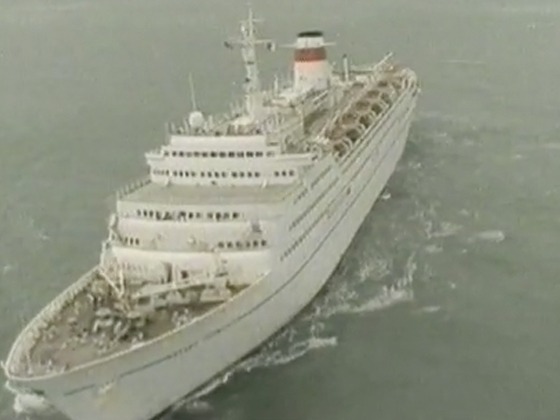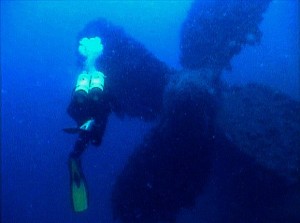I did my original dive qualification here in NZ, but where I really learned to become a diver was in the colder, darker and more tidal waters of the English Channel. That was 20 years ago now and at the time it was common place to see divers wearing nothing but tools instead of a weight-belt and to hear the sounds of lump hammers and chisels bashing away or the grinding of crowbars whenever we were wreck diving. In our dive club the divers who carried the most respect were those with the biggest trophy cabinets, the ones with real portholes cleaned up and as was a fashion at the time – inserted into various doors in their homes. It seems strange to me now, but back then the dream of many new divers was to find an undiscovered wreck with dozens of portholes just waiting to be plundered.
However, during the 90’s things started to change. Firstly laws were beefed up and enforced more stringently, meaning that in the majority of cases selling artefacts from wrecks became illegal and therefore divers could no longer fund their diving that way. Secondly a campaign to change diver’s attitudes towards wrecks became successful. So many of the most popular wrecks had been totally stripped that new divers were no longer excited by wreck diving. The once popular and respected club members became pariahs and taking artefacts virtually ceased.
New Zealand in 2015 feels more like the UK in 1990, diving wise that is, before you start moaning about UK immigrants not appreciating their newly adopted country. The salvage mentality popularised by the likes of Kelly Tarlton is still strong in NZ and even the new generation of divers are keen to ‘get a bit of wreck booty’ – that is if they are not obsessed with crays and scallops. As a consequence the location of many NZ wrecks is still a very closely guarded secret by those in the know and it is easy to understand why.
So is New Zealand behind the times or is it simply a case of the rest of the world becoming too politically correct? To illustrate the main points of debate I’d like to use one of NZ’s most iconic wrecks as an example – the Mikhail Lermontov.
However, before I get into the main arguments I first have a few words to say about the legal situation. In general laws are only any good if people believe in them and obey them and/or if they can be properly enforced. In the case of the Lermontov enforcement of any pertinent laws is incredibly difficult. The wreck has sunk in a very isolated area and any illegal salvage that does go on happens underwater, out of sight of almost everybody. For that reason I am more interested in the greyer areas of wreck salvage – is taking artefacts morally acceptable? The reason for this is that having experienced what happened in the UK I believe it will be the attitude of the general diving population in NZ that will have the most impact on how wrecks in NZ are treated.
The divers
The first point of debate is about the divers themselves. By allowing or promoting the taking of artefacts do more divers choose to come to NZ to dive? Without question there are definitely divers who visit because of the lure of finding and recovering artefacts. Would more divers visit if the wreck had a no-take policy? At this stage I would think the answer is no. The majority of well known wrecks around the world are no-take zones (e.g. all the wrecks of Chuuk Lagoon, The President Coolidge in Vanuatu) so at present the Lermontov attracts divers because it offers something different.
Of course one might argue that it is not all about commercial gain – but this is a horribly simplistic argument. Simply because something is done for commercial purposes does not make it wrong. The existence of successful charter companies catering to foreign divers also make it far easier for local divers to go diving – just think of the Poor Knights.
However, although taking artefacts may bring in divers at present, this is clearly not a sustainable strategy. The number of artefacts is limited so at some point there will be none left. Most other well known wrecks also previously allowed the taking of artefacts but stopped this practice when it became clear that if everything went then the divers would cease coming.
Another driving force behind certain divers is the belief that ‘If I don’t take it someone else will.’ This is a very commonly touted line but rubbish all the same. The inevitable conclusion to this argument will be that the wreck is picked bare. Basically I take because you take and you take because I take – brilliant logic. Lots of people take drugs, drive too fast, think racism is acceptable or beat up their partner, but that doesn’t mean I have to as well. (Ok, maybe the driving bit on occasion.)
Finally I even heard the argument about ‘Well it’s tradition isn’t it.’ Fine, you tell my wife that we are reverting to the old tradition of women not having the vote.
The artefacts
The second point of debate is the artefacts themselves. How many of us enjoy looking at good displays in museums and galleries? If there was a great selection of artefacts from the Lermontov on display at the Maritime Museum I would definitely go and have a look – so would most divers I imagine. Displaying artefacts helps to raise awareness of our maritime heritage and generate interest in our chosen sport.
But then displaying artefacts underwater also works brilliantly. Swimming through the Leningrad Lounge and seeing plates on display really brings it alive – that is until some idiot takes them without thinking why no one has taken such an obviously displayed plate before!
There is also the argument that if you recover an item from under a deep layer of silt then what has really changed about the wreck? No one would ever have seen the item anyway. This is a hard point to dispute, so I will follow it with another question: What happens once the artefact gets to the surface?
Some items do not survive once they reach the surface, such as beer and soft drink cans still full of liquid. In my opinion these should remain on the wreck – they help to bring bar and lounge areas alive. Other stuff like glasses and plates – well now that you have recovered them what are you going to do with them? A solitary plate or glass looks great immediately after the dive, but once left on a shelf at home with a lot of other random stuff it simply gets covered with dust and forgotten about – and unlike museum displays it is probably never seen by anyone else again. Those of you that have taken items from the Lermontov – is this what has happened in your case?
The wreck
Finally we have the wreck itself. The Mikhail Lermontov is relatively young by wreck standards. The significant majority of well known and highly popular wrecks currently dived are from the WWII era. At over 60 years old these are becoming increasingly fragile and broken up. We are lucky to have such an intact wreck and my belief is that with the continued collapse of other well known wrecks the Mikhail Lermontov will increase significantly in popularity. Which means we need to protect it.
There are already plenty of holes and entry points for divers – we do not need more. The idea that it is acceptable to smash another window to gain access to an area is hugely short-term. In my opinion if your skills are not up the level required to gain access to a particular area then you need to remedy those skills, not damage the wreck for all time to the detriment of all other divers. Of all the dive practices adopted by Lermontov divers today I find this one the most abhorrent.
Conclusions
I can easily understand why divers choose to take artefacts from wrecks. I have done so myself. However, whatever the reasons short-term for taking artefacts the inescapable conclusion is that at some point in the future the Lermontov will become a no-take zone – either legally or by mutual agreement between the various dive operators.
With the continued collapse of other wrecks and the growing awareness of the Lermontov around the world I expect the number of divers visiting this world class wreck dive to increase. If all of these new divers are allowed to take artefacts the Lermontov will become very boring and get broken up very quickly. Personally I would like to enjoy challenging and interesting dives on this majestic wreck for years to come.
So, I have stated the main arguments for and against as I’ve seen and heard them in NZ, but what are your opinions? The NZ wreck diving community is still relatively small, so what you believe and what you do will have an impact on how this situation develops. We would love to receive your comments.
From Jamie at Halcyon NZ

